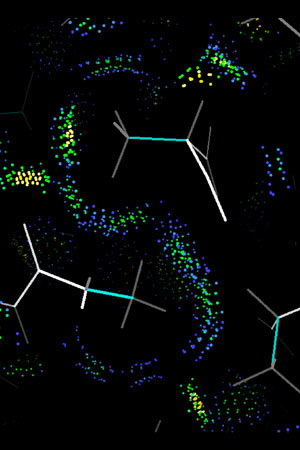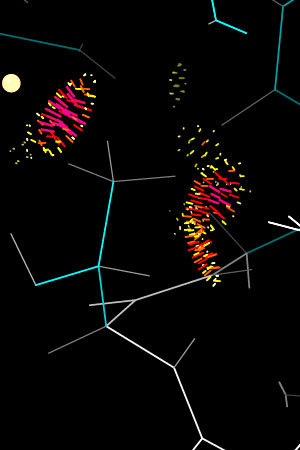

Since the beginning days of what has become "all-atom contact analysis", we've (overused) the word "dot". "Dotlist" is the object-type drawn by Mage to draw "dots", the colored, geometric objects to demarcate the van der Waal surfaces; "probe-dots" is what we occasionally call the technique; thus, "How Dots Work" is the title for this explanatory image and "The Dots Page" is this index page for the All-atoms Contact analysis section of our web site.
All-atom contact analysis is a powerful technique to assess the quality of a macromolecular structure by combining information about:
The logical basis of A-aC is simple:
Two critical actions occur in the methodology: placing the hydrogens and determining the van der Waal interactions. Our program Reduce places the hydrogens, and our program Probe calculates the vdW sphere interactions. The method and implementation are discussed in JM Word et al, (1999) "Visualizing and quantifying molecular goodness-of-fit: small-probe contact dots with explicit hydrogen atoms." J. Mol. Biol. 285, 1711-1733.
The "How Dots Work" figure above depicts how Probe works. To visualize the vdW sphere contacts, we "roll" a small probe (0.25Å) along the surface of each atom's vdWaal sphere and at points of the probe's contact with other atoms' vdW spheres place a dot, which is color-coded depending upon the type and depth of its interaction.


Contacts in accurate, high-resolution models give a pleasing pattern of close-contact blue/green dots which wind through the protein tracing the well-matched van der Waals radii as seen for this section between two alanines in 1GCI
When vdW radii overlap too much, we call this state a "clash", the depiction is not pleasing: hot-pink spikes signal the location of an error in the model. A clash at a threonine in 1BKR is shown.
All-atom contact analysis is a method that assesses and helps improve the quality / the accuracy of macro-molecular models. The method is manifested in the tools available at this website; tools available for use by the whole spectrum of users of these models - model-builders to gene-jockeys.
For structural-biologists, A-aC is exquisitely sensitive at identifying problem areas in the model. Some corrections are simple and have-been (Asn, Gln, His flips) or are in-the-process-of (rotamer selection) being automated. Other corrections are more involved (local backbone movements) requiring intelligent intervention, but A-aC in conjunction with our new tools speed and simplify that too.
For others, besides model quality assessment and problem localization - important aspects to any model use - A-aC can be used to guide mutation studies, enzyme design, etc.
MolProbity is the best place to get started with All-atom Contact analysis. MolProbity is our web service for A-aC; it runs on our servers, allowing you to either select a model from the PDB, or upload a coordinate file in PDB format.
The component programs and scripts of MolProbrity are available from this website for unix-like operating systems. Source code is also available. See the software section of this website.
The MolProbity package is available to run as a local server using your own Apache web server.
We now have a YouTube tutorial video explaining the basic concepts of the all-atom contact analysis.